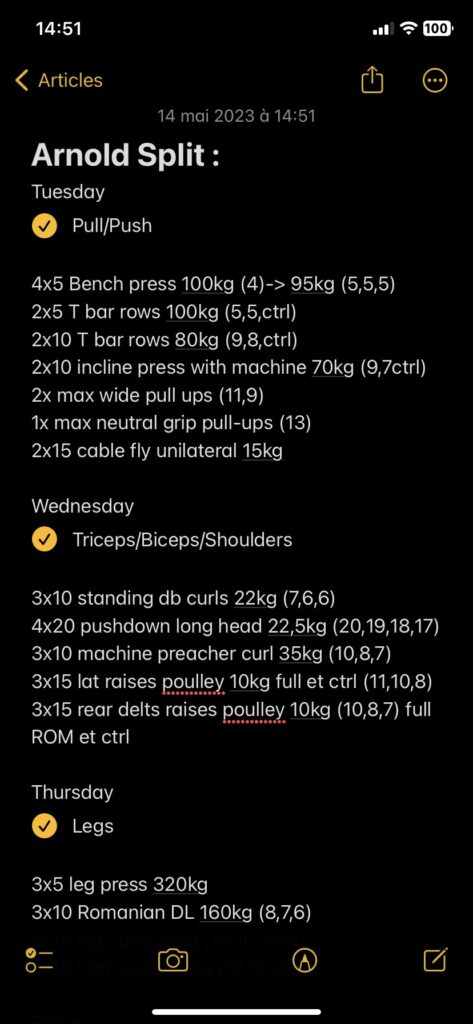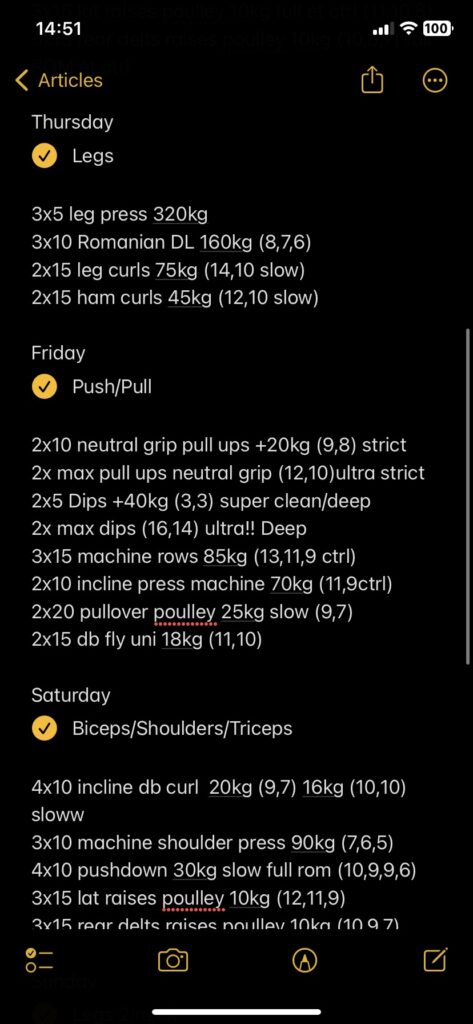1. Key principles regarding your training
Train hard/ Always aim to get better and stronger
This is one of the most important things, if not the most important thing to get right. The ability to push yourself hard during training alongside consistency over time is what is going to determine if you will get jacked or not.
On the first few weeks of training, try to learn how to properly execute the movements that you’re going to use in your training routines.
After you’ve learned how to properly execute these movements, push each set as hard as you physically can.
On heavy compounds lifts like squats, bench press and vertical presses variations, go as hard as possible but stop the set 1 rep before absolute failure (where you would be almost 100% sure you’re going to get stuck under the bar if you attempted one more rep).
On hip hinges like deadlift variations, good mornings, or rack pulls, go to physical failure where you do as many reps as possible but as soon as you’re not able to do a full rep anymore, stop the set. I would advise against going past failure on these movements as they are very stimulatory on the central nervous system and going past failure can negatively impact the rest of the workout and also going past failure may cause your form to break down which is not advisable for these movements as they put a lot of pressure on your lower back.
On vertical and horizontal pulling movements like pull-ups, rows, lat pull downs, go to physical failure and once physical failure is reached, try to get 1 or 2 more partial reps (or less clean reps).
On isolation movements, go to physical failure and beyond, don’t be afraid of doing even tiny reps.
Another particularly important thing is tracking your progress. You don’t necessarily have to track everything, but you should at least know for each exercise how much you’ve lifted before and for how many reps and with what form (slow tempo, full range of motion etc.). The easiest way to track that is with your phone.
This is how I do it:


As you can see, I have everything I need written down on my phone and every time I’m doing a set I try to beat my last performance on the lift (doing more reps, lifting more weight, lifting with a more controlled technique).
As you can see on the left of my notes, I have predetermined rep numbers for each movement. When I reach the rep number for the specific movement I move up in weight and after moving up in weight I focus on “cleaning up the technique” and doing more reps until I reach the rep number again and then I repeat the same process again and again.
Make your first training plan and track progression
I’m not going to go into much detail here as there are other posts specialized in training programming, but you need to start doing something right?
For simplicity’s sake here is a template that you can use to start your lifting journey, I would recommend copying the template as is at the beginning and modifying it afterwards as you learn more about training and get better at lifting weights.
Beginner Routine Template (first 6 months of training)
3 Days per Week PPL : Pull / Push / Legs
Pull
2-3 sets of 6-15 reps of a lat pull down variation / or a pull-up variation
2-3 sets of 6-15 reps of a rowing type of movement (T-bar rows, barbell rows, cable rows, machine rows)
1-2 sets of 6-15 reps of biceps isolation movement (standing barbell or dumbbell curl, hammer curl, incline curl)
2-3 sets of 10-20 of a rear delt raise type of movement
Optional :
Ab work :
1-2 sets of a leg raise, or knee raise type of movement
1-2 sets of a crunch type of movement
Push
2-3 sets of 6-15 reps of a pressing movement (barbell or dumbbell bench press, dips, machine press, incline bench press…)
2-3 sets of 6-15 reps of a vertical press (shoulder machine press, dumbbell seated overhead press, standing overhead press…)
1-2 sets of 6-15 reps of skull crushers (with barbell, easy bar or dumbbell) / or overhead triceps extensions with a pulley or a dumbbell, but with a pulley it is probably better.
2-3 sets of 10-20 reps of a lateral delt raise type of movement.
Optional
Ab work:
1-2 sets of 10-20 reps of a leg raise, or knee raise type of movement.
1-2 sets of 10-20 reps of a crunch type of movement
Legs
2-3 sets of 5-10 reps of a heavy quad focused movement (incline leg press, incline hack squat, high bar back squat, front squat)
2-3 sets of 5-10 reps of a hip hinge movement (Romanian deadlift, stiff legged deadlift, good mornings, sumo deadlift, rack pulls).
1-2 sets of 10-20 reps of a quad focused movement (machine leg curls, incline leg press, incline hack squat, high bar back squat, front squat)
1-2 sets of a hamstring isolation movement (Machine hamstring curl, Nordic curls, bodyweight hamstring curl variations).
Start with the lowest number of sets mentioned in this template and increase it afterwards when you feel that your work capacity and your ability to recover have improved. When you can easily do the greatest number of sets for each exercise on this template (somewhere after 4 to 6 months of training), it will then be time for you to switch to a more advanced/optimized type of programming where you will be training at least 4 times a week and doing more volume
You can find more about that on my other posts.
Be consistent!
Being consistent is key in bodybuilding as the persons who get the best results are not necessarily the ones that train the most intelligently or the ones that have the best genetics (although arguable), but instead they are the ones that train hard and for long periods of time (while focusing on progression). Be consistent!
2. Key principles on nutrition
Eat enough calories!
If you want to get big, eat, and eat a lot. You have to be in a calorie surplus to be able to put muscle optimally (or at least at maintenance calories when being 20% body fat or more). If you’re too fat to your liking to begin with, then focus on losing fat and getting under 20% body fat first. If or when you’re under 20% body fat just eat a lot and focus on always being in a calorie surplus of at least 300 calories a day. If you’re gaining fat too quickly, then lower your calories a bit, when you get too fat to your liking then cut and go down to a reasonable body fat % and bulk again. Repeat this process for as many times as you need to get to your goal physique.
Hit your protein intake
To build muscle optimally you need to eat enough protein. I’m not going to go into details, but scientific and anecdotal evidence tend to suggest that if you eat at least 80 to 100g of protein per day (at least 1g of protein per Kg of bodyweight) you will have more than enough protein to build muscle optimally. If you eat meat every day or almost every day you will certainly hit your protein intake. If you rarely or never eat meat, then look into protein supplementation.
A bit on supplements
Most of them are useless, at least in a performance context. I would not focus on buying supplements to increase performance in the gym, as the only ones that work will not have a significant impact on your progress. The supplements that are somewhat worth looking into are:
-creatine
-L-glutamine
-L-citrulline or citrulline malate
-protein powder (if protein intake is an issue or if it is convenient for you to use).
Conclusion
These are the few guidelines that you need to be religiously following when you’re just starting to go the gym. Only applying those few guidelines can get you far when it comes to building a jacked physique. My general recommendation would be for you to start applying these fundamentals and continue learning about bodybuilding concepts as you go and incorporate them further down your lifting journey.

